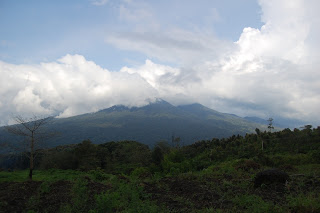 This sweet banana is often found as banana fritters. However, I have discovered that quite a few of my Sunday market customers also enjoy eating it raw and also used them to make banana pancakes or locally known as lempeng.
This sweet banana is often found as banana fritters. However, I have discovered that quite a few of my Sunday market customers also enjoy eating it raw and also used them to make banana pancakes or locally known as lempeng.This banana has a nice smooth feel to the skin and is a lighter yellow in color. The body of the fruit is more rounded with soft edges and the end is slightly elongated before reaching the end.
At the farm, the tree grows up to 8m tall with a thick pseudostem. The inflorescence of this is bitter hence I do not recommend it to be eaten as ulam. There are two types of this banana, one with seeds and one without. My preference is the one without and it definitely spoils the enjoyment of banana fritters when you bite into the seed which has a slight bitter taste. At the farm, we only plant the ones without seeds.
The banana has a very sweet taste, sweeter when it is harvested when fully matured and ripened naturally without the use of chemical agents. Due to its high sugar content, you will find that the frying oil turns brown rather rapidly when making banana fritters due to the caramelization of the natural sugars. I have also experimented making banana bread with it and find that you can reduce the sugar suggested in the recipes and also taste great when made using unprocessed sugar.
The inflorescence of this banana plant can also be eaten as ulam or cooked to make savory dishes.
Hence, if your purchase them when just ripened, you can consume it raw as it has firm texture with a sweet taste. As it futher ripens, you can transform them into banana fritters or pancake and when it is over-ripen, you can turn them into banana bread or cake or even pancakes. With so many options, it is definitely a versatile banana.
















